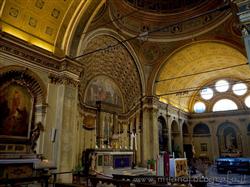|
Church of Santa Maria at San Satiro
|
|
|
Show an other treasure of art and history in Milan:
|
 Mostly represented styles: Renaissance Mostly represented styles: Renaissance
The church of Santa Maria at San Satiro has a complex history. First of all it must be said that it consists in fact of two parts, of very different ages. On the one hand the Shrine of San Satiro (otherwise also known as the Chapel of Mercy, not depicted on this page), bult in the late ninth century and currently positioned outside the tip of the left transept, on the other hand the proper church (Church of Santa Maria), from the Renaissance period.
The Shrine of San Satiro is architecturally very interesting and has features that correlate with religious buildings in eastern Europe, and even Armenia. Its current version, however, is the result of the restoration performed by Bramante, that, especially with regard to the outside, has introduced many changes.
The Church of Santa Maria at San Satiro, almost hidden in a rather narrow court, it is inconspicuous from the outside and has a facade of gray stone. The church was built, starting from 1480, commissioned by the Duke Galeazzo Maria Sforza and designed by the young architect Donato Bramante.
Inside, the church of Santa Maria presso San Satiro, which has a T-shaped layout and three naves, is richly decorated. The roof of the main nave is golden and gives a lovely warm glow to the environment.
The treasure, however, is represented by the false apse, which seems to lie behind the altar, and instead it's just a relief applied to the back wall. The illusion is so strong, that you have to get really close to realize that it is such.
It was made so for purely practical reasons, because of the lack of enough space to built a real apse.
The false perspective of Bramante was partially ruined during the first half of the nineteenth century by Pizzogalli, who built the present altar and placed behind it, within a frame, the image of Virgin with child and two donors that previously was on the outside.
We should also mention the beautiful trichrome marble floor under the dome, which represents its schematic projection, the baptistery (initially sacristy) and the terracotta group of the late fifteenth century Lamentation over the Dead Christ , which is currently placed the Shrine of San Satiro.
Finally, the facade was actually completed only at the end of the nineteenth century, while the circular windows at the end of the right transept are of the first half of this century.
If you are interested in a guided tour of this monument send an email!
Categories: Churches / Religious buildings
via Speronari, 3 - 20123 Milano |
Further pictures of the Church of Santa Maria at San Satiro in the section Photography |